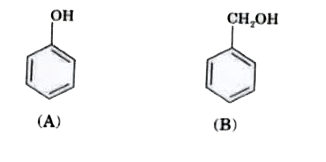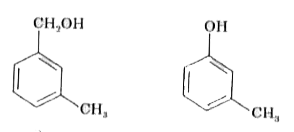What are phenols? How do they differ structurally from aromatic alcohols?
Step-by-Step Text Solution:
1. Definition of Phenols:
- Phenols are organic compounds characterized by the presence of a hydroxyl group (-OH) attached directly to an aromatic hydrocarbon ring. The simplest example of a phenol is phenol itself (C6H5OH), where the -OH group is attached to a benzene ring.
2. Structure of Phenols:
- In phenols, the carbon atom to which the hydroxyl group is attached is part of the aromatic system. This carbon is typically sp² hybridized, meaning it is involved in a planar structure with a bond angle of approximately 120 degrees.
3. Definition of Aromatic Alcohols:
- Aromatic alcohols, on the other hand, are compounds where the hydroxyl group is attached to a carbon atom that is not part of the aromatic ring itself. Instead, the -OH group is connected to an aliphatic carbon that is adjacent to the aromatic ring.
4. Structure of Aromatic Alcohols:
- In aromatic alcohols, the carbon atom bearing the hydroxyl group is typically sp³ hybridized. This means that the carbon atom is tetrahedral in shape with bond angles of about 109.5 degrees.
5. Key Differences:
- The primary structural difference between phenols and aromatic alcohols lies in the attachment of the hydroxyl group:
- In phenols, the -OH group is directly attached to an sp² hybridized carbon in the aromatic ring.
- In aromatic alcohols, the -OH group is attached to an sp³ hybridized carbon that is adjacent to the aromatic ring.
6. Conclusion:
- Both phenols and aromatic alcohols contain the hydroxyl functional group and are considered aromatic compounds. However, their structural differences in the attachment of the -OH group lead to different chemical properties and reactivities.
---
- Phenols are organic compounds characterized by the presence of a hydroxyl group (-OH) attached directly to an aromatic hydrocarbon ring. The simplest example of a phenol is phenol itself (C6H5OH), where the -OH group is attached to a benzene ring.
- In phenols, the carbon atom to which the hydroxyl group is attached is part of the aromatic system. This carbon is typically sp² hybridized, meaning it is involved in a planar structure with a bond angle of approximately 120 degrees.
- Aromatic alcohols, on the other hand, are compounds where the hydroxyl group is attached to a carbon atom that is not part of the aromatic ring itself. Instead, the -OH group is connected to an aliphatic carbon that is adjacent to the aromatic ring.
- In aromatic alcohols, the carbon atom bearing the hydroxyl group is typically sp³ hybridized. This means that the carbon atom is tetrahedral in shape with bond angles of about 109.5 degrees.
- The primary structural difference between phenols and aromatic alcohols lies in the attachment of the hydroxyl group:
- In phenols, the -OH group is directly attached to an sp² hybridized carbon in the aromatic ring.
- In aromatic alcohols, the -OH group is attached to an sp³ hybridized carbon that is adjacent to the aromatic ring.
- Both phenols and aromatic alcohols contain the hydroxyl functional group and are considered aromatic compounds. However, their structural differences in the attachment of the -OH group lead to different chemical properties and reactivities.
Topper's Solved these Questions
- BOOK - PRADEEPCHAPTER - ALCOHOLS, PHENOLS AND ETHERSEXERCISE - ADDITIONAL QUESTIONS (LONG ANSWER QUESTIONS)6videos
ALCOHOLS, PHENOLS AND ETHERS
- BOOK - PRADEEPCHAPTER - ALCOHOLS, PHENOLS AND ETHERSEXERCISE - HIGHER ORDER THINKING SKILLS (QUESTIONS AND PROBLEMS WITH ANSWERS/SOLUTION)5videos
ALCOHOLS, PHENOLS AND ETHERS
- BOOK - PRADEEPCHAPTER - ALCOHOLS, PHENOLS AND ETHERSEXERCISE - ADDITIONAL QUESTIONS (VERY SHORT ANSWER QUESTIONS)58videos
ALCOHOLS, PHENOLS AND ETHERS
- BOOK - PRADEEPCHAPTER - ALDEHYDES, KETONES AND CARBOXYLIC ACIDS EXERCISE - IMPORTANT QUESTIONS FOR BOARD EXAMINATION29videos
ALDEHYDES, KETONES AND CARBOXYLIC ACIDS
Similar Questions
Knowledge Check
- Question 1 - Select One
Which of the following compounds is aromatic alcohol?

 AA,B,C,DBA,DCB,CDA
AA,B,C,DBA,DCB,CDA
What are the two types of mRNAs ? How do they differ ?
View SolutionWhat are plant growth hormones ? How do they differ from growth regulators ?
View SolutionWhich of the following compunds is aromatic alcohol?
 View Solution
View SolutionWhat are metallic interstitial hydrides? How do they differ from molecular hydrides?
View SolutionHow do fungi differ from algae ?
View SolutionFungi differ from algae in being
View SolutionHow do algae differ from fungi?
View Solution

